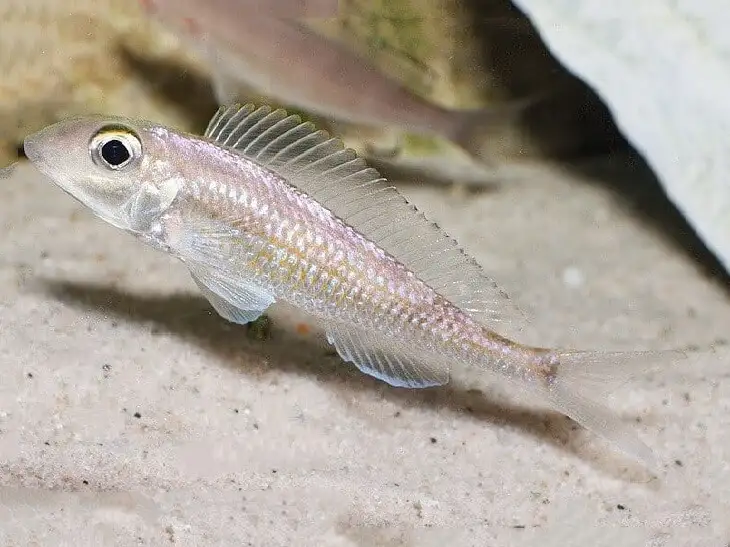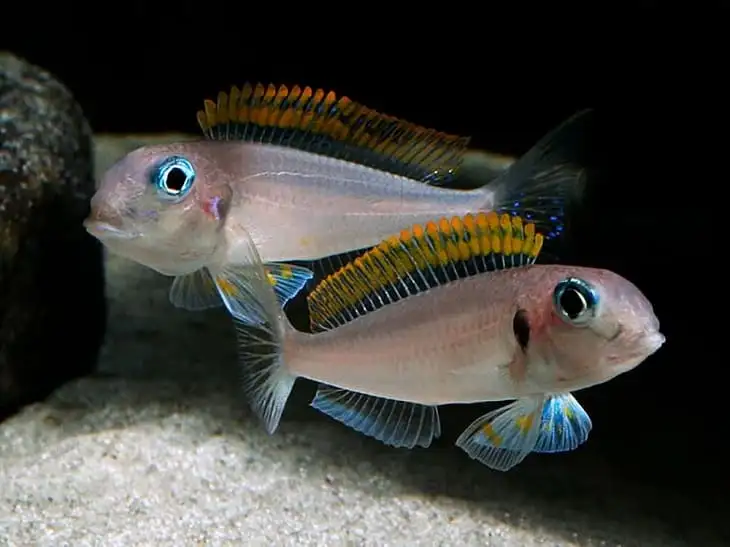Xenotilapia leptura

Xenotilapia leptura or Asprotilapia leptura naturally inhabits the African Lake Tanganyika. It is one of the strangest looking African cichlids. Xenotilapia leptura can hardly be called a sand cichlid, as it lives in shallow rocky habitat, at a depth of 1 to 10 m and feeds on algae growing on rocks, although the rocks are often surrounded by strips of sand.
The body of Xenotilapia leptura is slender and elongated, and appears even longer, as the strongly bifurcated caudal fin is also elongated. The body color is grayish-silver with a thin black border on the dorsal fin. The maximum length is 11 cm. There is no difference in coloration or body shape between the sexes, but the male is usually slightly larger than the female. Compared with most other representatives of the genus Xenotilapia has only two lateral lines and tricuspid teeth. Very characteristic is extremely lowered mouth and prominent spout.
To keep a group of 2-3 pairs need an aquarium of 250 liters. It is desirable to buy just a small flock of fish (8-10 individuals) and allow them to form pairs themselves. Should not be kept Xenotillapii fine-tailed singly or in an amount less than 4 fish, because this can lead to increased levels of aggression.
The aquarium should have plenty of open space for free swimming fish. Fine sand should be used as a substrate. Several large stones should be placed at the bottom. Ideal neighbors for these fish are Cyprichromis leptosoma (Cyprichromis leptosoma).
Water parameters: temperature 23-27° C, hardness dH 8-11°, pH 7,5-9,0. Requires filtration, aeration and a weekly change of ¼ of the aquarium water with fresh.
Since Xenotilapia leptura in nature feeds mainly on algae, both unicellular and filamentous. Under aquarium conditions, the fish should be fed plant foods. The fish are best fed with specialized pelleted and flake food designed for African cichlids. Also give the fish cyclops and Artemia nauplii. Feed the fish in small portions several times a day.
Reproduction
Thin-tailed Xenotilapia refers to monogamous cichlids, in which both the female and male incubate eggs in the mouth.
Both in nature and in the aquarium, fish mate and occupy a small area, which zealously guard. The area is most often a fragment of rock or a group of rocks. During the spawning period, the fish take a contrasting color. At this time the edge of the fins becomes clearly visible, and the head turns dark. Males, as well as females, often open the gill lids and show their qualities by inflating them.
The female hatches a few eggs, which are immediately fertilized by the male, and the female collects them in her mouth. Initially, only the female incubates the eggs and larvae in her mouth. During the incubation period, which usually lasts 18-21 days, the pair stays close to each other and protects their territory. Around the middle of the incubation period, the larvae are transferred to the male, who takes full care of them. About 10-12 days after the transfer of larvae from the female, the male releases well-formed fry about 8-10 mm in size from his mouth. Both male and female look after the fry for a few more days, the cubs take refuge in the mouth of the parents (usually the male) in case of danger. One litter may contain 14 to 30 fry.
From the first days of life, the fry feed on microalgae, which they peck off rocks.
Xenotilapia leptura has a life span of 6-8 years under aquarium conditions.








